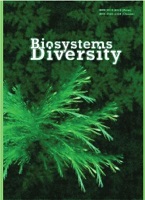Ornithogalum boucheanum (Asparagaceae) in Eastern Europe: Native and synanthropic range, habitat conditions and state of population
Ornithogalum boucheanum (Asparagaceae) in Eastern Europe: Native and synanthropic range, habitat conditions and state of population
Author(s): O. I. Shynder, Y. M. Nehrash, T. V. Mamchur, T. M. KostrubaSubject(s): Environmental Geography, Human Ecology, Political Ecology, Environmental interactions
Published by: Дніпропетровський національний університет імені Олеся Гончара
Keywords: flora of Ukraine; rare species; alien species; ergasiophygophyte; geographical distribution; habitats; naturalization;
Summary/Abstract: The geographical distribution, ecological and coenotic features of the place of growth and age structure of Ornithogalum boucheanum populations in Ukraine have been studied. In total, during the entire period of floristic research in Ukraine, 263 native sites of this species were recorded in 13 administrative regions (oblasts). Mostly these sites are concentrated in the Steppe zone, where the main part of the Eastern European fragment of the general natural range of O. boucheanum is represented. For other regions of Ukraine isolated reports of the species are known. It is noted that in addition to reduction in the number of natural habitats of O. boucheanum within the Forest-Steppe and in the southern part of Ukraine Polissya, a secondary adventive natural habitat of the species is formed, where it is part of the immigration group of foreign taxa. It was found that the natural habitats of O. boucheanum are characterized by a certain stenotopy, as the species needs some moisture and is more common in valley and balka landscapes most often in large river basins, which are not prone to drying out and can be favourable ecological corridors for long-distance migration. Favourable conditions for O. boucheanum habitats exist in floodplain and riparian forests, which have sufficient moisture, little competition from other species of grass and a sufficient amount of light in the spring. In addition, O. boucheanum can successfully master artificial and synanthropic groups of tree species, in particular being widespread in the Forest-Steppe and Steppe Robinia plantations. It was found that populations of O. boucheanum in Ukraine have different numbers: with an area of 4–6 hectares, in which there are tens and hundreds of thousands of individuals, to small populations on the northern border of distribution, in Kirovohrad and Kharkiv oblasts, which have a of young invasive character. It is possible that modern conditions have been favourable for the spread of O. boucheanumin the transition zone between the Forest-Steppe and Steppe, and that the process of forming new populations of O. boucheanumis taking place here.
Journal: Biosystems Diversity
- Issue Year: 31/2023
- Issue No: 1
- Page Range: 59-70
- Page Count: 12
- Language: English

